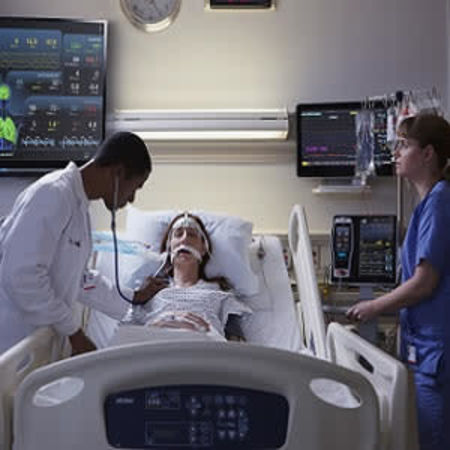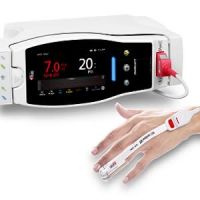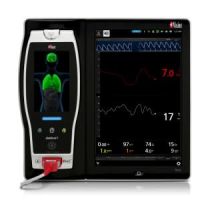Masimo announced today the release of UniView™, an integrated display of real-time data and alarms from multiple Masimo and third-party devices, designed to reduce clinician cognitive overload and improve patient safety. UniView promotes data sharing and team coordination among multiple clinicians.
In operating rooms (ORs), in intensive care units (ICUs), and in other areas which involve multiple clinical disciplines, clinicians are often unable to simultaneously view data from all of the various medical devices in use, resulting in information that remains siloed among, for example, anesthesiologists, surgeons, and nurses. In addition, the plethora of displays and user interfaces adds to cognitive overload that can cause clinician burnout and suboptimal patient care.
UniView solves these problems by bringing together data from a variety of sources – such as patient monitors, ventilators, anesthesia gas machines, and IV pumps – and providing a supplementary display for them, clearly organized, on one or more large, central monitors, so that all clinicians can simultaneously view and act upon the same, comprehensive real-time patient status and historical trends. Visual alarm indicators, relayed from the connected devices, help clinicians recognize patient distress and target areas for immediate focus. UniView is suitable for any area where comprehensive, logically organized, and timely data are key to supporting good clinical care.
UniView also provides tailored, use-case-specific screen layouts which optimize the presentation of advanced and integrated parameters, trend data, and waveforms for a variety of clinical scenarios, making it a versatile solution in many environments. For example:
- In Overview layout, view monitoring data from all connected point-of-care and therapeutic devices including waveforms and alarms, for an overview of patient status.
- In Hemodynamics layout, view trend data for noninvasive hemoglobin (SpHb®), pleth variability index (PVi®), and pulse rate to aid in visualizing patient status over time.
- In Oxygenation layout, view ventilator waveforms alongside noninvasive trended hemoglobin (SpHb) and oxygen saturation (SpO2) to monitor a patient’s oxygenation status.
- In Sedation layout, view high-fidelity EEG waveforms, patient state index (PSi), and anesthesia machine data to monitor a patient’s sedation.
In addition, hospitals will be able customize the view as preferred and even take advantage of individual customization using Masimo MyView™ technology.
Joe Kiani, Founder and CEO of Masimo, said, “We are answering clinicians’ calls for logical, clinically transformational cockpits for the collaborative ORs and ICUs of the future. UniView is a great example of Masimo’s ongoing commitment to automating patient care, whether it’s making pulse oximeters accurate when you need that accuracy most, creating new noninvasive monitoring technologies such as SpHb, or in this case, unsiloing data, enhancing connectivity, and communicating patient data as effectively and efficiently as possible, so that clinicians can focus more on their patients. We look forward to introducing additional enhancements soon – helping to bring automation and connectivity to the next level.”
UniView builds on the success of Kite™, which projects data from Root® on a larger screen, by aggregating data from all of the connected devices in a room, including third-party ones, so that a supplemental display of all monitoring data can be viewed by all. UniView works in conjunction with Masimo Iris Gateway™ and Patient SafetyNet™* connectivity platforms. Complementing UniView, the recently announced Masimo Replica™ allows clinicians to view similar monitoring data for multiple patients, as well as view and respond to alarms and alerts, all from a smart phone, regardless of location.
References
- Castillo A et al. Prevention of Retinopathy of Prematurity in Preterm Infants through Changes in Clinical Practice and SpO2 Technology. Acta Paediatr. 2011 Feb;100(2):188-92.
- de-Wahl Granelli A et al. Impact of pulse oximetry screening on the detection of duct dependent congenital heart disease: a Swedish prospective screening study in 39,821 newborns. BMJ. 2009;Jan 8;338.
- Taenzer AH et al. Impact of Pulse Oximetry Surveillance on Rescue Events and Intensive Care Unit Transfers: A Before-And-After Concurrence Study. Anesthesiology. 2010; 112(2):282-287.
- Taenzer AH et al. Postoperative Monitoring – The Dartmouth Experience. Anesthesia Patient Safety Foundation Newsletter. Spring-Summer 2012.
- McGrath SP et al. Surveillance Monitoring Management for General Care Units: Strategy, Design, and Implementation. The Joint Commission Journal on Quality and Patient Safety. 2016 Jul;42(7):293-302.
- Estimate: Masimo data on file. http://health.usnews.com/health-care/best-hospitals/articles/best-hospitals-honor-roll-and-overview.
Latest Articles
Masimo, real-time data, UniView™
Masimo announced today the release of UniView™, an integrated display of real-time data and alarms from multiple Masimo and third-party devices, designed to reduce clinician cognitive overload and improve patient safety.



























